Pity the poor landlord, stuck with a boatload of hassles: late rent payments, missed payments, tenants who disappear, tenants who trash the place before they leave.
The list of risks with owning rental property goes on and on! All just to (hopefully) collect a rent check at the end of the month.
But there’s a much easier way to rake in steady income from real estate without the hassle of dealing with tenants and other risks of owning property outright.
The best part?
You’ll get an 8% return on your money in cash every single year. And we’re going to do it straight from our brokerage accounts, just as if we’re buying shares of a company like Apple (AAPL)—but without the pathetic 1.4% dividend Tim Cook’s firm pays.
I’m talking about real estate investment trusts (REITs), companies that own everything from seniors’ homes to warehouses and must—by law—hand out 90% of their earnings as dividends.
That results in dividends that are twice as high, on average, as those of your typical S&P 500 stock—so around 3.5% on average. (My colleague Brett Owens recently named 3 high-yield REITs set to rise with interest rates. Click here to read that article.)
Your Own REIT “Dividend Magnifier”
Of course, buying REITs on their own is a great way to boost your income stream.
But what few folks know is there’s a simple trick that doubles your REIT dividends (and more): buying REITs through closed-end funds (CEF), a special group of funds that also trades on the stock market and regularly pays 8%+ yields.
And two of these 8%-paying funds are on sale right now (including one that’s so small and off the radar that Wall Street has ignored it—for now—giving us a one-time opportunity to buy cheap).
Before I get to those, though, let’s talk for just a second about how REITs work.
REITs 101
In a nutshell, REITs pool cash from investors and use it to buy a bunch of properties, which they then rent out to tenants. REITs have a board of directors that manages those properties, takes care of cash flow and pays out dividends to shareholders.
It’s a simple enough business model, and it works very well. In fact, it works better than betting on the broader market over the long haul.
Just compare the SPDR Dow Jones REIT ETF (RWR), an index fund that owns the largest US REITs, and the SPDR S&P 500 ETF (SPY) over the last couple decades:
REITs a Clear Winner
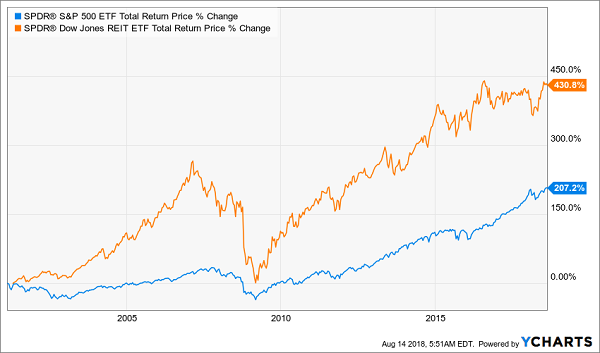
RWR clearly won on a total-return basis because of its higher dividend yield, which boosts its overall returns to more than double those of the S&P 500.
Which is where CEFs come in, because while RWR’s 3% income stream is nice, CEFs help us make the leap all the way up to those 8%+ payouts I mentioned earlier.
2 Great REIT CEFs to Buy Now
While there are dozens of REIT CEFs out there, two are standouts with tremendous price upside ahead, on top of their massive income streams.
The first is the Cohen & Steers REIT & Preferred Income Fund (RNP), an 8.1% yielder that invests in many of the REITs that are also in RWR. That also means RNP is well diversified across the US and holds a wide range of properties:
A Variety of Holdings
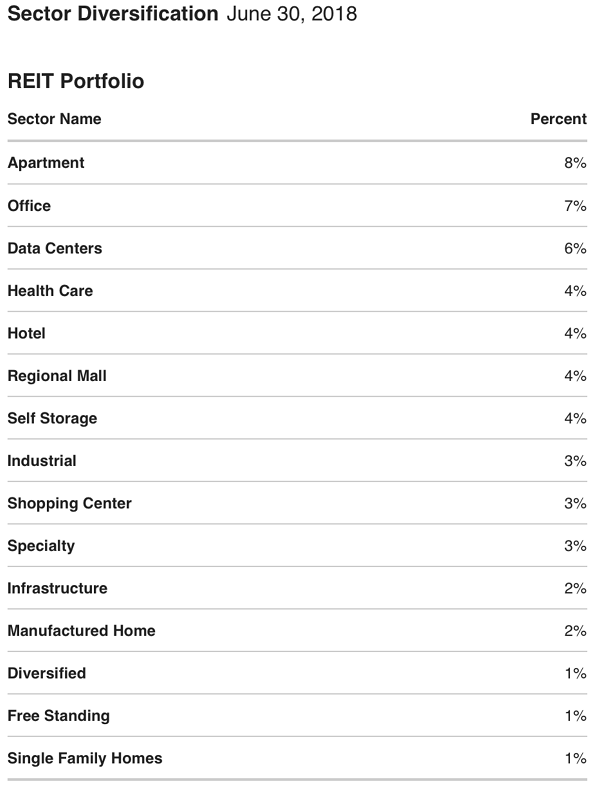
Source: Cohen & Steers
And RNP’s well-balanced approach works:
Massive Returns for the Long Term
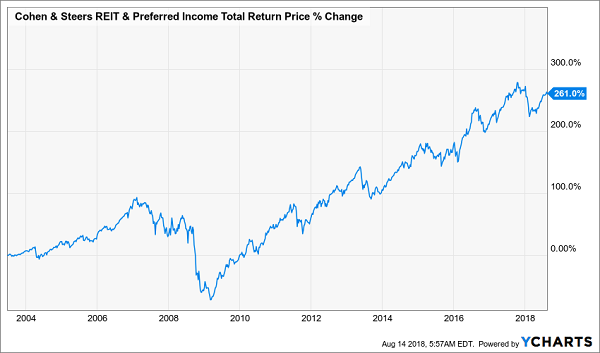
RNP is up over 260% since its IPO 15 years ago, making it a particularly potent REIT play. But there’s one other great thing about this CEF: it’s on sale.
Since RNP is a CEF, its market price differs from its net asset value (or the liquidation value of all of its REIT holdings). That difference has gotten quite big in recent months: the fund now trades at a 10.4% discount to NAV, near the biggest markdown in the last year:
A Sale Appears
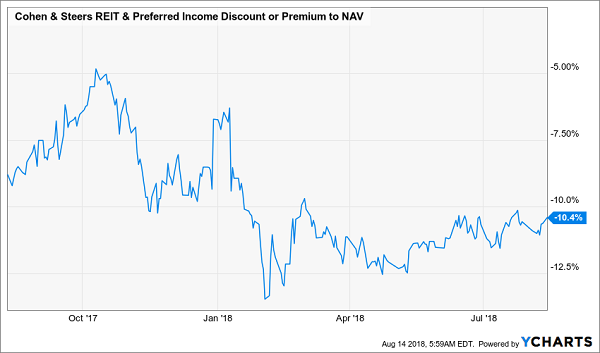
That discount has started to close, and I expect to narrow more later in 2018, pushing RNP’s share price higher, which is why this fund should be on your radar now.
Another Fire-Sale Fund for 8% Dividends
The second REIT fund to consider is the Principal Real Estate Income Fund (PGZ), which trades for a whopping 14.1% discount to NAV—one of the biggest discounts of any real estate CEF.
That’s just one reason to like this fund.
The other is its portfolio, which holds many of the largest and best-performing REITs, such as Equinix (EQIX) and Prologis (PLD), and is well diversified across different property types and throughout the United States.
That gives you an extra level of safety, and there’s another reason to consider this 8%-yielding REIT fund: it’s a hidden secret most of Wall Street doesn’t know about, but I suspect more folks will discover it soon.
To put in perspective how small PGZ is, let me first tell you that the index fund for REITs (RWR) holds $2.5 billion of assets. And RNP has $1.4 billion in assets under management.
PGZ? Just $137.5 million.
This is by design. PGZ began with just about $120 million in assets, and the fund’s managers clearly want to keep it small. PGZ’s assets haven’t grown as much as its total return in the last half-decade because it focuses on returning as much profit to shareholders as possible in the form of cash dividends. That’s partly why it’s such a reliable passive income machine.
And here’s the other upshot of that small size: because of PGZ’s tiny market cap, big investors who know about it and its potential can’t earn enough of a profit from the fund to bother buying. And small investors simply lack the research acumen or market knowledge to discover PGZ and its potential.
That makes it a rare overlooked gem that gives you a high income stream with capital-gain potential—and that’s why you should consider snapping it up now, before the rest of the market discovers it and that big discount to NAV disappears.
Bonus: My No. 1 CEF Pick Now (8.1% Dividends and Quick 20%+ Gains)
Smaller funds like PGZ are the key to big profits in CEFs, and many of these unsung cash machines fly below the radar, not only because of their size but because big fund companies like Vanguard pour all of their marketing cash into overhyped ETFs.
That’s a huge disservice to investors, because it draws their attention away from winners like my No. 1 CEF pick now, which pays an 8.1% dividend and has demolished the market in the last decade:
High Yields and Massive Gains

So why isn’t this top-performing fund, which is run by some of the smartest minds in the pharmaceutical business, a household name?
For one, this low-key CEF is tiny, with just a $391-million market cap, so like PGZ, it gets zero attention from Wall Street or the financial media.
For another, if you strip out the dividend and look at the fund on a price basis alone (the blue line below), my No. 1 pick looks like a terrible loser…
The Herd’s Looking at the Wrong Chart!
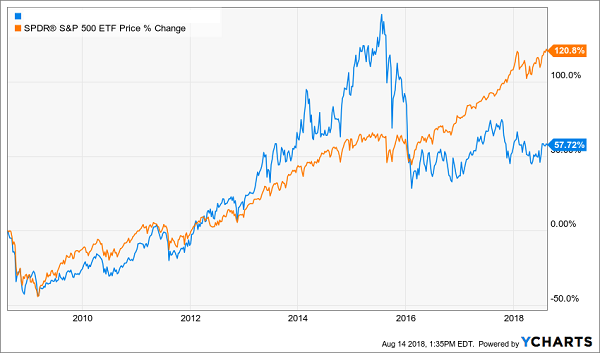
It’s only when you add this fund’s monstrous dividend back in that you get that huge 282% GAIN, which was almost entirely in CASH.
Yet as I write, this fund trades at a 4% discount to NAV! That may not sound like much, but it’s traded at fat premiums to NAV many times in the past 5 years.
When it does so again, we’ll be locked in for fast 20%+ upside from here, on top of that massive dividend!
My No. 1 pick is just one of 5 funds I’ve uncovered with SAFE dividends up to 10%, plus 20%+ price gains ahead in the next 12 months.
The best news? The details on all of them are just a click away. Just go right here and I’ll give you full details on these 5 income (and growth) plays: names, ticker symbols, buy-under prices and more.
